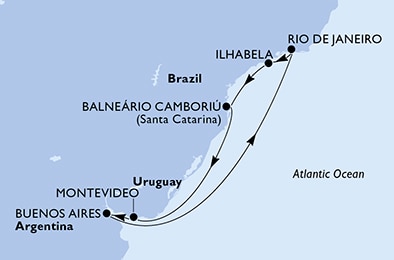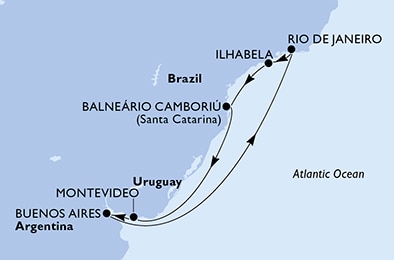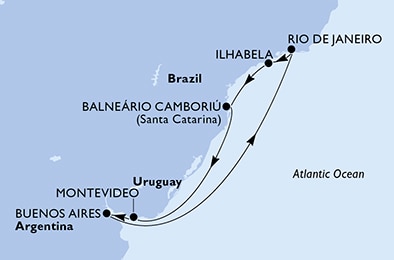
Port Buenos Aires
Buenos Aires, the capital of Argentina, is a city brimming with culture, history, and vibrant energy. Known as the "Paris of South America," its European-style architecture and wide boulevards are complemented by lively neighborhoods, each with its own charm. In La Boca, visitors can stroll through the colorful Caminito street, a hub of tango performances and local art. Meanwhile, Recoleta is home to the famous Recoleta Cemetery, where icons like Eva Perón rest in elaborate mausoleums. The historic Teatro Colón, one of the world’s finest opera houses, and the grand Avenida 9 de Julio, featuring the iconic Obelisco, add to the city's architectural and cultural allure.
Beyond its landmarks, Buenos Aires is renowned for its dynamic lifestyle and culinary scene. Neighborhoods like San Telmo and Palermo offer trendy cafes, bustling markets, and vibrant tango shows that capture the city’s essence. Food lovers can indulge in Argentine specialties such as asado (barbecue) and empanadas, paired with the famous Malbec wine. Football enthusiasts can immerse themselves in the electric atmosphere of games at La Bombonera or El Monumental stadiums. With its rich history, passionate culture, and endless charm, Buenos Aires promises an unforgettable experience for visitors.
History
Buenos Aires, the capital of Argentina, is a city with a rich and dynamic history that blends European influences with a unique Latin American identity. Founded twice, first in 1536 by Pedro de Mendoza and then permanently in 1580 by Juan de Garay, Buenos Aires grew as a key port city due to its location along the Río de la Plata. During the colonial era, it became an important hub for trade, despite restrictions imposed by Spanish authorities. The city's independence-minded spirit culminated in its significant role in the May Revolution of 1810, which led to Argentina's independence from Spain.
In the late 19th and early 20th centuries, Buenos Aires underwent rapid growth, fueled by European immigration, particularly from Italy and Spain. This period saw the city transform into a cosmopolitan cultural and economic center, earning it the nickname "The Paris of South America" due to its elegant architecture and thriving arts scene. Today, Buenos Aires is celebrated for its vibrant neighborhoods like San Telmo and La Boca, the iconic Teatro Colón, and its status as the birthplace of tango. The city's mix of tradition and modernity makes it one of the most captivating capitals in the world.





 With air transport to the port
With air transport to the port





